Directions (1-5): What will come in place of (?) in the following number series?
Q1. 17,21,37,73,137, 237,?
(a)361
(b)381
(c)337
(d)327
(e)435
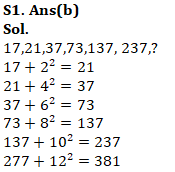
Q2. 0,3,1,5,4,7,9,9, 16, ? ,25
(a)15
(b)17
(c)14
(d)11
(e)13
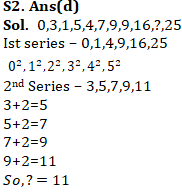
Q3. 12, 14, 20, 32, 52, 82, ?
(a)115
(b)106
(c)124
(d)132
(e)123
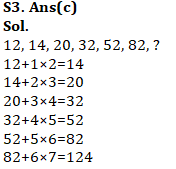
Q4. 0, 4, 18, 48, 100, ?
(a)170
(b)156
(c)125
(d)196
(e)180
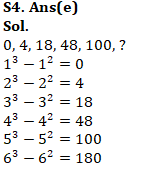
Q5. 256, 384, 960, 3360, ?
(a)15120
(b)9820
(c)12150
(d)10280
(e)8260
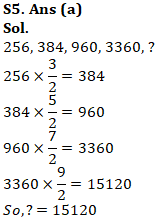
Directions (6-10): In the following questions, calculate quantity I and quantity II, compare them and answer
Q6.
Quantity I. Find the original speedof the train(in kmph),a train travels a distance of 750km at a constant speed. If the speed of the train increased by 25 km/hr. the journey would take 1 hr less.
Quantity II. Find the original speed of the train (in kmph), a train leaves the station 3 hours before the scheduled time. The driver decreases its speed by 30 km/hr. At the next station 1800 km away, the train reached on time. Find the original speed of the train.
(a) If quantity I > quantity II
(b) If quantity I < quantity II
(c) If quantity I ≥ quantity II
(d) if quantity I ≤ quantity II
(e) if quantity I = quantity II or no relation can be established
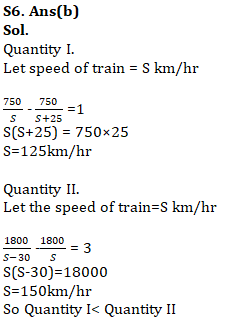

(a) If quantity I > quantity II
(b) If quantity I < quantity II
(c) If quantity I ≥ quantity II
(d) if quantity I ≤ quantity II
(e) if quantity I = quantity II or no relation can be established
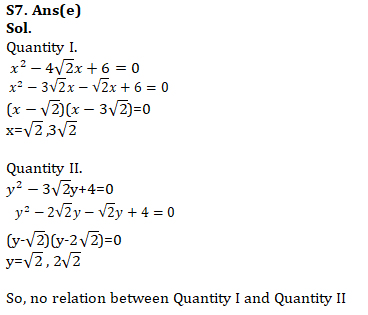
Q8.
Quantity I. find percentage loss, if a retailer marks up his price by 30% and then allows a discount of 25%. What is % loss
Quantity II. find percentage loss,if a retailer marks up his price by 25% and then allows a discount of 30%. What is % loss
(a) If quantity I > quantity II
(b) If quantity I < quantity II
(c) If quantity I ≥ quantity II
(d) if quantity I ≤ quantity II
(e) if quantity I = quantity II or no relation can be established
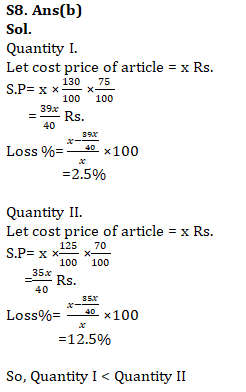
Q9.
Quantity I. find the Area of the triangle ![]() ),A triangle with the base of 6 cm and the height of 8 cm. find the area of triangle.
),A triangle with the base of 6 cm and the height of 8 cm. find the area of triangle.
Quantity II. find the Area of the rectangle ![]() ,A rectangle has the breadth of 6cm and its length is
,A rectangle has the breadth of 6cm and its length is ![]() more than its breadth. Find area of the rectangle.
more than its breadth. Find area of the rectangle.
(a) If quantity I > quantity II
(b) If quantity I < quantity II
(c) If quantity I ≥ quantity II
(d) if quantity I ≤ quantity II
(e) if quantity I = quantity II or no relation can be established
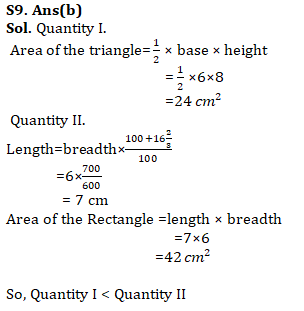
Q10.
Quantity I. On a certain sum of money, the compound interest for 2 years is 381.6 and the simple interest for the same period of time is Rs 360. The rate of interest per annum is.
Quantity II. the difference between simple interest and compound interest on an amount of Rs 8000 for 2 years is Rs 20. What is the rate of interest per annum?
(a) If quantity I > quantity II
(b) If quantity I < quantity II
(c) If quantity I ≥ quantity II
(d) if quantity I ≤ quantity II
(e) if quantity I = quantity II or no relation can be established
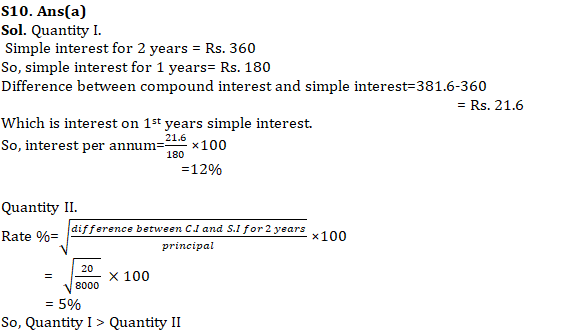
Directions (11-15) :- The given table shows the number of votes cast in a city in given years. Some data is missing. Study the following table and answer the following questions.
Some value are missing in the table, you are expected to calculate the missing values if it is required to answer the given questions as per the information provided in the question.

Q11. The total number of votes increased by 40% in 2018 with respect to 2015 and out of which only 20% votes are invalid. Find the no. of valid votes in 2018.
(a) 224
(b) 896
(c) 1024
(d) 908
(e) 696
![]()
Q12. If the average no. of valid votes in 2014 and 2016 are 1000. Find the total no. of votes cast in 2016.
(a) 1250
(b) 1750
(c) 1000
(d) 750
(e) 1500
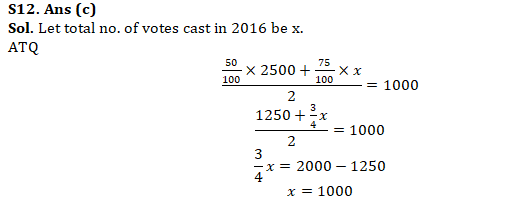
Q13. What was the respective ratio of no. of valid votes of A to no. of valid votes of B in year 2014, if the no. of valid votes of B was 650 in the same year?
(a) 12 : 25
(b) 13 : 12
(c) 13 : 25
(d) 12 : 13
(e) 11 : 13

Q14. If 55% of total cast votes are valid in year 2015, find the difference between valid votes of A and B in the same year?
(a) 240
(b) 150
(c) 180
(d) 90
(e) 120

Q15. In 2016, the difference between no. of valid votes of A and B was 225. What was the total no. of votes cast in 2016?
(a) 1500
(b) 1300
(c) 1700
(d) 900
(e) 1100

If you want to study Quantitative Aptitude for IBPS PO Prelims then you can also check out the video given below:
- Quantitative Aptitude Study Notes for Bank Exams
- Quantitative Aptitude Questions for all Competitive Exams





 GA Capsule for SBI Clerk Mains 2025, Dow...
GA Capsule for SBI Clerk Mains 2025, Dow...
 The Hindu Review October 2022: Download ...
The Hindu Review October 2022: Download ...
 ECGC PO Scorecard 2025 Out, Check Marks
ECGC PO Scorecard 2025 Out, Check Marks




